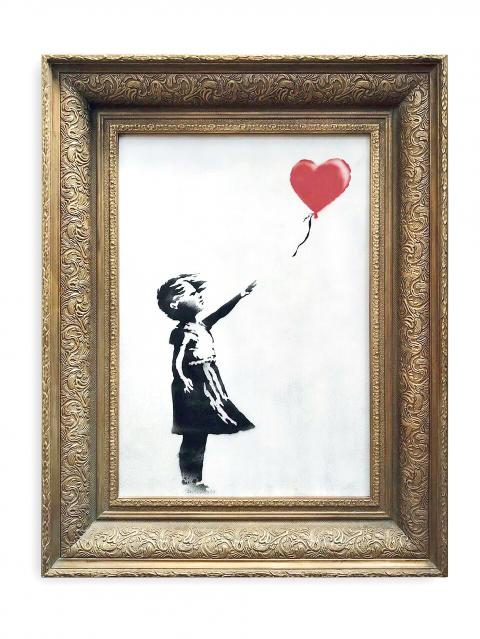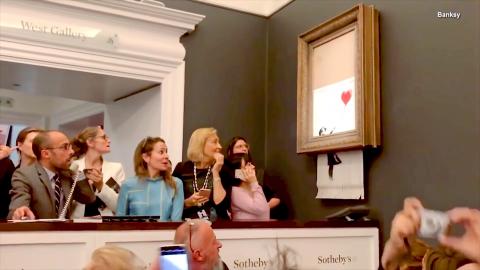The spray-painted work Girl with Balloon, by the mysterious artist who goes by the name Banksy, was put on sale at Sotheby’s in London earlier this month. Soon after the hammer fell, with a final auction price of US$1.4 million, the painting began emitting a beeping sound, and the canvas began to slip down as it was fed through a paper shredder installed inside the frame. Just as suddenly as it had started, it stopped, with only half of the canvas shredded.
The media lapped up the ensuing astonishment and confusion. Banksy would later release a short video on his Instagram site showing the process of installing the shredder, revealing himself to have been the culprit behind it. He had wanted to prevent the sale of the work, should it ever be put up for auction.
Graffiti artist Banksy started his own brand of guerilla warfare from Britain, targeting cities throughout the world with works of social criticism and satirical comment on capitalism. This type of self-destruction, the anti-art approach on display on this occasion, of fighting against the idea that art is a commodity to the bought and sold, has a precursor in Dada, Conceptual Art and Performance Art. Marcel Duchamp (1887-1968) famously entered a signed urinal for an art auction, in so doing creating a Dadaist masterpiece.

Photo: AP
照片:美聯社
When the auction hammer hits the gavel, it is not just the price of the auctioned work that is being decided, it is the piece’s place in history and its market value. With every auction, these are being renegotiated and redefined. The mechanism of the art market is an even more mysterious, invisible hand; the market value, represented by money, has symbolic significance collectively decided by the society.
As such, Sotheby’s announced that Banksy’s Girl with Balloon was the first instance in the history of art in which the work was essentially created within the auction venue, and that it would rename the new piece Love is in the Bin and sell it to the original winning bidder at the auction price. It seems that Banksy hath protested too much; could it be that he has been seduced by capitalism’s dark side?
Banksy subsequently released another video, with a shot showing a hand pressing a remote switch in the auction house, followed by another showing the process of testing the shredding device — in which the entire canvas was successfully cut into strips — as a way to explain his true intent. In this, the creation of this new work could only have been possible in the social media age: a living artist engaged in a dialectical negotiation with an auction house and the media, even to the extent of manipulating the orientation of the discourse surrounding it. This meta art approach succeeded in deconstructing the traditional passive process of a work of art having its value decided from outside.

Photo: Screen grab from YouTube
照片:擷圖自YouTube
(Translated by Paul Cooper)
代號「班克西」的匿名藝術家,其噴漆畫《Girl with Balloon》(氣球女孩)本月初在倫敦的蘇富比拍賣會上標售,美金一百四十萬元落槌後,這畫開始嗶嗶作響,然後畫布一瀉而下,穿透畫框內藏的碎紙機絞成碎條……然後奇異地,中途忽然停止,只碎了一半。
這種驚嚇與困惑,席捲了全球媒體,之後班克西在他的Instagram社群網站發佈了一段影片,揭露把碎紙機裝進畫框的過程——原來始作俑者是他自己,理由是防止此畫被拍賣。

Photo: Wikimedia Commons
照片:維基共享資源
班克西以塗鴉游擊戰從英國發跡,以社會批判、嘲諷資本主義之姿打遍各城。其實這種自毀、「反藝術」——反對藝術作為商品買賣的做法其來有自——例如達達、觀念藝術、行為藝術等。杜象(西元一八八七~一九六八年)把簽了化名的小便斗送進藝術拍賣會,便是達達的傑作之一。
在拍賣會這蓋棺論定的場域,一落槌所敲定的不只是售價,而是藝術史的地位與市場價值。每一次的拍賣,都是一場再討論、再定位。藝術市場機制是一隻更神秘、更隱而不見的手,金錢所代表的市場價值,是社會集體商定的符號象徵意義。
於是,蘇富比宣布,《氣球女孩》是藝術史上第一件在拍賣會中完成的作品,將改名為《Love is in the Bin》(愛在垃圾桶),按原拍定的價格賣給原得標者。班克西對於資本市場的收編,不過是欲拒還迎。
班克西再度發布影片,顯示臥底在拍賣會裡的人按下遙控器,以及測試時整幅畫全部絞碎的情況,為自己辯解。因此這件作品的創作,還擴及社群媒體時代所特有的過程——在世的藝術家和拍賣會、媒體交互辯證詮釋,甚至操縱輿論走向,這種後設手法,大大解構了其傳統待價而沽的被動角色。
(台北時報林俐凱)

In an effort to fight phone scams, British mobile phone company O2 has introduced Daisy, an AI designed to engage phone con artists in time-wasting conversations. Daisy is portrayed as a kindly British granny, exploiting scammers’ tendency to target the elderly. Her voice, based on a real grandmother’s for authenticity, adds to her credibility in the role. “O2” has distributed several dedicated phone numbers online to direct scammers to Daisy instead of actual customers. When Daisy receives a call, she translates the scammers’ spoken words into text and then responds to them accordingly through a text-to-speech system. Remarkably, Daisy

Bilingual Story is a fictionalized account. 雙語故事部分內容純屬虛構。 Emma had reviewed 41 resumes that morning. While the ATS screened out 288 unqualified, she screened for AI slop. She could spot it a mile away. She muttered AI buzzwords like curses under her breath. “Team player.” “Results-driven.” “Stakeholder alignment.” “Leveraging core competencies.” Each resume reeked of AI modeling: a cemetery of cliches, tombstones of personality. AI wasn’t just changing hiring. It was draining the humanity from it. Then she found it: a plain PDF cover letter. No template. No design flourishes. The first line read: “I once tried to automate my

Every May 1, Hawaii comes alive with Lei Day, a festival celebrating the rich culture and spirit of the islands. Initiated in 1927 by the poet Don Blanding, Lei Day began as a tribute to the Hawaiian custom of making and wearing leis. The idea was quickly adopted and officially recognized as a holiday in 1929, and leis have since become a symbol of local pride and cultural preservation. In Hawaiian culture, leis are more than decorative garlands made from flowers, shells or feathers. For Hawaiians, giving a lei is as natural as saying “aloha.” It shows love and

1. 他走出門,左右看一下,就過了馬路。 ˇ He walked outside, looked left and right, and crossed the road. χ He walked outside and looked left and right, crossed the road. 註︰並列連接詞 and 在這句中連接三個述語。一般的結構是 x, y, and z。x and y and z 是加強語氣的結構,x and y, z 則不可以。 2. 他們知道自己的弱點以及如何趕上其他競爭者。 ˇ They saw where their weak points lay and how they could catch up with the other competitors. χ They saw where their weak points lay and how to catch up with the other competitors. 註:and 一般連接同等成分,結構相等的單詞、片語或子句。誤句中 and 的前面是子句,後面是不定詞片語,不能用 and 連接,必須把不定詞片語改為子句,and 前後的結構才相等。 3. 她坐上計程車,直接到機場。 ˇ She took a cab, which took her straight to the airport. ˇ She took a cab and it took her straight